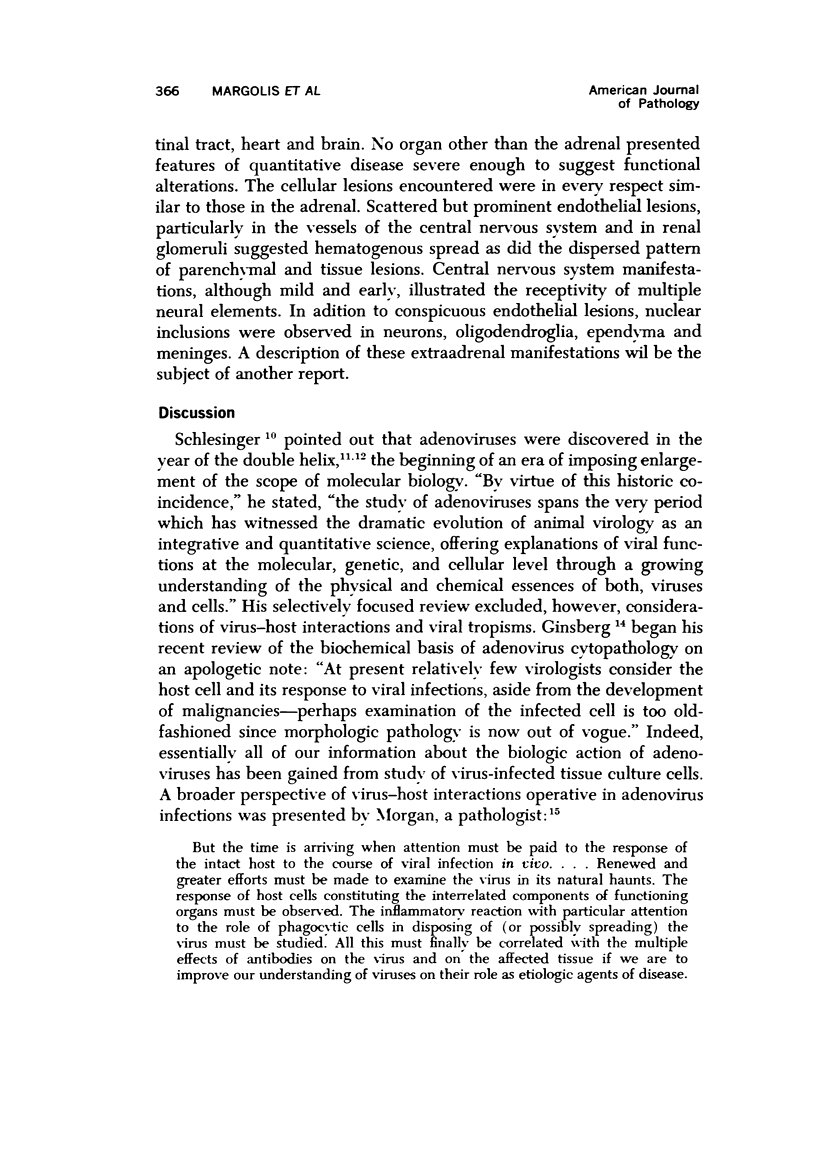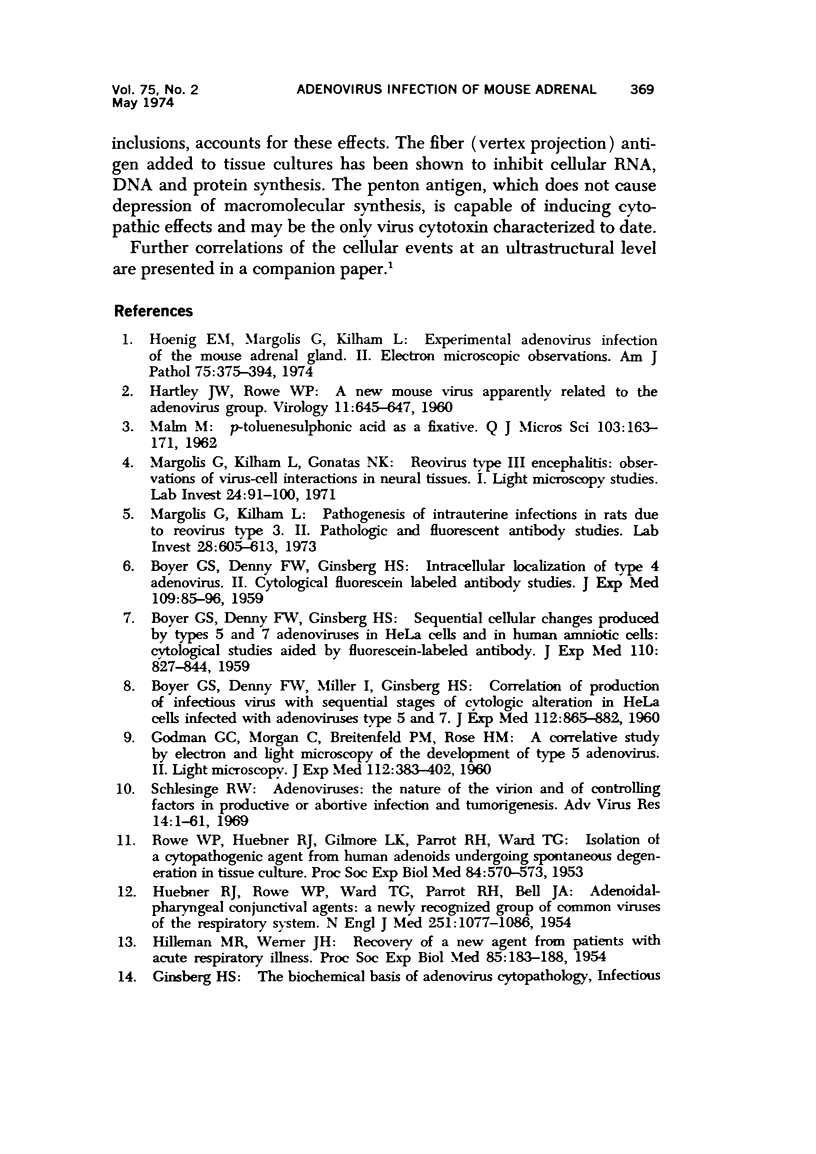Abstract
A murine type of adenovirus has been found to have a highly selective affinity for the adrenal of its natural host. In view of the adrenal pathology in Addison's disease, which consists of cortical atrophy and focal lymphocytic infiltration, the possibility of a viral causation is an attractive hypothesis. The striking adrenotropism of this agent offers, theoretically, a potential experimental animal model for investigation of this possibility. Most of our information about the acute biologic action of adenoviruses has been gained from study of virus-infected tissue culture cells. The sharply focused and severe attack of the murine agent upon a prime target organ facilitates correlative in vivo studies of the cytopathology of adenovirus infection at levels of light and electron microscopy.
Full text
PDF











Images in this article
Selected References
These references are in PubMed. This may not be the complete list of references from this article.
- Anghelescu V., Cighir R. Citomegalia în raport cu tarele biologice ale sugarului. Stud Cercet Inframicrobiol. 1968;19(6):413–417. [PubMed] [Google Scholar]
- BOYER G. S., DENNY F. W., Jr, GINSBERG H. S. Intracellular localization of type 4 adenovirus. II. Cytological and fluorescein-labelled antibody studies. J Exp Med. 1959 Jan 1;109(1):85–96. doi: 10.1084/jem.109.1.85. [DOI] [PMC free article] [PubMed] [Google Scholar]
- BOYER G. S., DENNY F. W., Jr, GINSBERG H. S. Sequential cellular changes produced by types 5 and 7 adenoviruses in HeLa cells and in human amniotic cells; cytological studies aided by fluorescein-labelled antibody. J Exp Med. 1959 Nov 1;110:827–844. doi: 10.1084/jem.110.5.827. [DOI] [PMC free article] [PubMed] [Google Scholar]
- BRAIN R. T., PUGH R. C., DUDGEON J. A. Adrenal necrosis in generalized herpes simplex. Arch Dis Child. 1957 Apr;32(162):120–126. doi: 10.1136/adc.32.162.120. [DOI] [PMC free article] [PubMed] [Google Scholar]
- Bahrani M., Boxerbaum B., Gilger A. P., Rosenthal M. S., Teree T. M. Generalized herpes simplex and hypoadrenocorticism. A case associated with adrenocortical insufficiency in a prematurely born male: clinical, virologic, ophthalmological, and metabolic studies. Am J Dis Child. 1966 Apr;111(4):437–445. doi: 10.1001/archpedi.1966.02090070135023. [DOI] [PubMed] [Google Scholar]
- CHEATHAM W. J., DOLAN T. F., Jr, DOWER J. C., WELLER T. H. Varicella: report of two fatal cases with necropsy, virus isolation, and serologic studies. Am J Pathol. 1956 Sep-Oct;32(5):1015–1035. [PMC free article] [PubMed] [Google Scholar]
- EHRLICH R. M., TURNER J. A., CLARKE M. Neonatal varicella; a case report with isolation of the virus. J Pediatr. 1958 Aug;53(2):139–147. doi: 10.1016/s0022-3476(58)80165-1. [DOI] [PubMed] [Google Scholar]
- FISHER E. R., DAVIS E. Cytomegalic-inclusion disease in the adult. N Engl J Med. 1958 May 22;258(21):1036–1040. doi: 10.1056/NEJM195805222582103. [DOI] [PubMed] [Google Scholar]
- GODMAN G. C., MORGAN C., BREITENFELD P. M., ROSE H. M. A correlative study by electron and light microscopy of the development of type 5 adenovirus. II. Light microscopy. J Exp Med. 1960 Aug 1;112:383–402. doi: 10.1084/jem.112.2.383. [DOI] [PMC free article] [PubMed] [Google Scholar]
- HALL G. F., CUNLIFFE A. C., DUDGEON J. A. Prolonged generalised vaccinia. J Pathol Bacteriol. 1953 Jul;66(1):25–38. doi: 10.1002/path.1700660105. [DOI] [PubMed] [Google Scholar]
- HARTLEY J. W., ROWE W. P. A new mouse virus apparently related to the adenovirus group. Virology. 1960 Jul;11:645–647. doi: 10.1016/0042-6822(60)90109-4. [DOI] [PubMed] [Google Scholar]
- HILLEMAN M. R., WERNER J. H. Recovery of new agent from patients with acute respiratory illness. Proc Soc Exp Biol Med. 1954 Jan;85(1):183–188. doi: 10.3181/00379727-85-20825. [DOI] [PubMed] [Google Scholar]
- HOSIER D. M., NEWTON W. A., Jr Serious Coxsackie infection in infants and children; myocarditis, meningoencephalitis, and hepatitis. AMA J Dis Child. 1958 Sep;96(3):251–267. doi: 10.1001/archpedi.1958.02060060253001. [DOI] [PubMed] [Google Scholar]
- HUEBNER R. J., ROWE W. P., WARD T. G., PARROTT R. H., BELL J. A. Adenoidal-pharyngeal-conjunctival agents: a newly recognized group of common viruses of the respiratory system. N Engl J Med. 1954 Dec 30;251(27):1077–1086. doi: 10.1056/NEJM195412302512701. [DOI] [PubMed] [Google Scholar]
- HULLINGHORST R. L., STEER A. Pathology of epidemic hemorrhagic fever. Ann Intern Med. 1953 Jan;38(1):77–101. doi: 10.7326/0003-4819-38-1-77. [DOI] [PubMed] [Google Scholar]
- Heck F. C., Jr, Sheldon W. G., Gleiser C. A. Pathogenesis of experimentally produced mouse adenovirus infection in mice. Am J Vet Res. 1972 Apr;33(4):841–846. [PubMed] [Google Scholar]
- Hoenig E. M., Margolis G., Kilham L. Experimental adenovirus infection of the mouse adrenal gland. II. Electron microscopic observations. Am J Pathol. 1974 May;75(2):375–394. [PMC free article] [PubMed] [Google Scholar]
- Johnson K. M., Halstead S. B., Cohen S. N. Hemorrhagic fevers of Southeast Asia and South America: a comparative appraisal. Prog Med Virol. 1967;9:105–158. [PubMed] [Google Scholar]
- KIBRICK S., BENIRSCHKE K. Severe generalized disease (encephalohepatomyocarditis) occurring in the newborn period and due to infection with Coxsackie virus, group B; evidence of intrauterine infection with this agent. Pediatrics. 1958 Nov;22(5):857–875. [PubMed] [Google Scholar]
- LAURANCE B., CUNLIFFE A. C., DUDGEON J. A. Vaccinia gangrenosa; the report of a case of prolonged generalized vaccinia. Arch Dis Child. 1952 Oct;27(135):482–486. doi: 10.1136/adc.27.135.482. [DOI] [PMC free article] [PubMed] [Google Scholar]
- LUKES R. J. The pathology of thirty-nine fatal cases of epidemic hemorrhagic fever. Am J Med. 1954 May;16(5):639–650. doi: 10.1016/0002-9343(54)90270-3. [DOI] [PubMed] [Google Scholar]
- Levy N. L., Notkins A. L. Viral infections and diseases of the endocrine system. J Infect Dis. 1971 Jul;124(1):94–103. doi: 10.1093/infdis/124.1.94. [DOI] [PubMed] [Google Scholar]
- MOOSSY J., GEER J. C. Encephalomyelitis, myocarditis and adrenal cortical necrosis in Coxasackie B3 virus infection. Distribution of the central nervous system lesions. Arch Pathol. 1960 Nov;70:614–622. [PubMed] [Google Scholar]
- Margolis G., Kilham L., Gonatas N. K. Reovirus type 3 encephalitis: observations of virus-cell interactions in neural tissues. I. Light microscopy studies. Lab Invest. 1971 Feb;24(2):91–100. [PubMed] [Google Scholar]
- Margolis G., Kilham L. Pathogenesis of intrauterine infections in rats due to reovirus type 3. II. Pathologic and fluorescent antibody studies. Lab Invest. 1973 May;28(5):605–613. [PubMed] [Google Scholar]
- Miller D. R., Hanshaw J. B., O'Leary D. S., Hnilicka J. V. Fatal disseminated herpes simplex virus infection and hemorrhage in the neonate. Coagulation studies in a case and a review. J Pediatr. 1970 Mar;76(3):409–415. doi: 10.1016/s0022-3476(70)80481-4. [DOI] [PubMed] [Google Scholar]
- NELSON E. R. Hemorrhagic fever in children in Thailand. Report of 69 cases. J Pediatr. 1960 Jan;56:101–108. doi: 10.1016/s0022-3476(60)80294-6. [DOI] [PubMed] [Google Scholar]
- PIYARATN P. Pathology of Thailand epidemic hemorrhagic fever. Am J Trop Med Hyg. 1961 Sep;10:767–772. doi: 10.4269/ajtmh.1961.10.767. [DOI] [PubMed] [Google Scholar]
- PUGH R. C., DUDGEON J. A., BODIAN M. Kaposi's varicelliform eruption (eczema herpeticum) with typical and atypical visceral necrosis. J Pathol Bacteriol. 1955 Jan-Apr;69(1-2):67–80. [PubMed] [Google Scholar]
- ROWE W. P., HARTLEY J. W. A general review of the adenoviruses. Ann N Y Acad Sci. 1962 Nov 30;101:466–474. doi: 10.1111/j.1749-6632.1962.tb18887.x. [DOI] [PubMed] [Google Scholar]
- ROWE W. P., HUEBNER R. J., GILMORE L. K., PARROTT R. H., WARD T. G. Isolation of a cytopathogenic agent from human adenoids undergoing spontaneous degeneration in tissue culture. Proc Soc Exp Biol Med. 1953 Dec;84(3):570–573. doi: 10.3181/00379727-84-20714. [DOI] [PubMed] [Google Scholar]
- SMITH M. G., VELLIOS F. Inclusion disease or generalized salivary gland virus infection. AMA Arch Pathol. 1950 Dec;50(6):862–884. [PubMed] [Google Scholar]
- Schlesinger R. W. Adenoviruses: the nature of the virion and of controlling factors in productive or abortive infection and tumorigenesis. Adv Virus Res. 1969;14:1–61. doi: 10.1016/s0065-3527(08)60556-4. [DOI] [PubMed] [Google Scholar]
- WONG T. W., WARNER N. E. Cytomegalic inclusion disease in adults. Report of 14 cases with review of literature. Arch Pathol. 1962 Nov;74:403–422. [PubMed] [Google Scholar]
- WORTH W. A., Jr, HOWARD H. L. New features of inclusion disease of infancy. Am J Pathol. 1950 Jan;26(1):17-35, incl 4 pl. [PMC free article] [PubMed] [Google Scholar]
- WYATT J. P., SAXTON J. Generalized cytomegalic inclusion disease. J Pediatr. 1950 Mar;36(3):271-94, illust. doi: 10.1016/s0022-3476(50)80097-5. [DOI] [PubMed] [Google Scholar]
- van der Veen J., Mes A. Experimental infection with mouse adenovirus in adult mice. Arch Gesamte Virusforsch. 1973;42(3):235–241. doi: 10.1007/BF01265648. [DOI] [PubMed] [Google Scholar]







